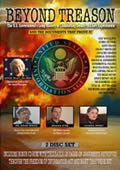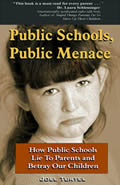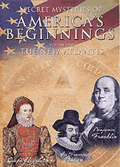PART 2 of 4
By
Marilyn MacGruder Barnewall
August 5, 2012
NewsWithViews.com
In a 2010 article titled “APES: Active Passive Energy Syndrome,” I explained the two different personality types that dominate American culture. Well, they dominate culture everywhere, but my research applied the concept to America. It was a series of two articles that explained why some of us are liberal and why some of us are conservative.
APES has definite application to American history. It has important connotations as to what decisions we will make for the future, and why.
A brief overview of the two personality styles is:
1. An Active is a person who comes by wealth by actively managing the risk of loss of one’s own assets to achieve it. Those assets may be money, they may be lifestyle, they may be a home and children, and they may be a job or profession. Wealth is made up of many elements. The character of the person determines the decisions made in life and the decisions made will characterize each person as either Active or Passive.
Thus, Actives are the shopkeepers of America, the independent business owners and the inventors. They are the free enterprisers.
2. Passives are people who come by wealth by allowing others to manage risk of loss for them. Rather than managing the risk of running their own businesses, they become part of a big corporation, for example. Thus, most teachers, professors, corporate executives (yes, even Lee Iacocca… he didn’t lend/risk his own money to save Chrysler; he risked the money of taxpayers), bureaucrats, media types – are Passives.
One good example of the differences between these two groups is their investment habits. Actives invest in themselves… in their ideas, in their businesses. Passives invest in the stock market or their partnership with other CPAs and lawyers (Actives usually have their own, independent practices). Passives create investment products that spread (rather than manage) risk… hedge funds and mutual funds (and life insurance).
Please remember the reference – these explanations represent a brief overview, not an in-depth explanation of a highly complex concept. Four pages of one sentence personality descriptions accompany the research (two pages for each group).
Why am I revisiting this subject? Because most Americans feel the fight between one group and the other; many consider it a fight between good and evil (and it is). Others consider it a fight between political parties (and it is). Still others see it as a fight between freedom and slavery (and it is).
In truth, it is a fight between the preferred lifestyles of Actives (who are motivated by control) and Passives (who are motivated by power). Actives want to control their own destinies (which is why they invest the majority of assets in themselves – something they can control – not the stock or bond markets). Security-motivated Passives invest in stocks and bonds, insurance, hedge and mutual funds – things controlled by others which spread the potential risk of loss. Most people think power and control are the same things. They are not. Control is something one does behind one’s own nose; power is something one exercises behind the noses of others. For a more in-depth explanation, I suggest you read the 2010 APES article.
A look at six Active/Passive energy cycles in American history offers good insight into how each of these groups weave threads into a beautiful blanket resulting in a capitalist country called America.
During the 1600s through the mid-1700s, our nation was known as British North America. Diaries written by early American residents describe local economies as almost totally dependent for survival upon agriculture.
There being little accommodation for visitors, tourism contributed a minuscule portion to local economies. There was minimal trade with European nations, but no delivery system existed from one American community to another. Thus, until the mid-1760's, America had village economies driven by agriculture.
In 1760, the colonies entered a state of unrest. They also entered their first economic cycle driven by Active energies. Those energies motivated the Revolutionary War of the 1770's that ended in 1781. A rag-tag group of America’s colonial soldiers defeated the most dominant military in the world at that time.
Patrick Henry’s cry of “Give me liberty, or give me death,” tells of a man motivated by the management of risk to achieve the moral objective of his right to self-destiny. His cry is the theme song for Active/self investors. To freedom-loving people, there is nothing more exciting than a positive possibility and the desire to make it a reality.
Prior to the Revolutionary War (which gathered momentum from 1760 until the infamous tea party and resultant war over taxation without representation), the American economy and its political structure was controlled by the Crown... by outside forces.
What kinds of people leave a secure, well-ordered society in Europe for the insecurity of unsettled foreign shores? Part of the answer lies in the promise of land ownership and the right to self-destiny. The answer to the question? Actives, the risk managers of the world, leave the security of a well-ordered society for the insecurities of building a new nation.
In the America of old, our ancestors had no control over laws passed to govern them. During the first fifty year cycle (1607/Jamestown to 1660), there were so few people on the continent, so little wealth, so much disease and discomfort, the American colonists were relatively free to pursue their own destinies. A difficult, high-risk destiny it was. There was no “economic drive.” There was no “social agenda.” There was no “political agenda.” The agenda was survival. It was a high-risk environment -- but it offered land and wealth to those who could tolerate and manage risk.
Settling a wild, undeveloped land attracted those with Active energy whose high tolerance for risk management made them willing to wager their lives for freedom from religious persecution and the right to own their own land. There were other benefits – and downsides – too.
They may have been taxed by the British Crown, their laws may have come from foreign soil, but until the 1700's, there was not a great deal of interference from the British King’s military in the lives of American settlers.
The “nation” was so young during this time it could not really be defined as having an economic force with a primary drive. As I said, the primary drive was survival.
From 1660 to 1710, that changed. Wealth began to increase. Free enterprisers established modes of transportation ... stage and shipping companies. Entrepreneurs built small inns and hotels for travelers and tourists. Farms were plentiful. Shipping created an industry of its own with foreign nations of the world.
Security and wealth attract ... what? The Passive energy group. By 1710, the risks of survival on American soil were reduced as the risk-takers completed their jobs. Actives had established a functional social base. Opportunities for the wealth of future generations by land accumulation and the need for products and services in the new country were broadened.
Those with a lower tolerance for risk, motivated by the security of being able to own land, were attracted to American shores. The immediate objective changed from the risk management of establishing a workable social base and the daily life challenges involved in doing so, to making things bigger and more secure. Remember, bigger is safer than smaller and Passives are security-motivated people who like the security of “big.” Thus, we can see from our own history (though it has been the same in all nations of the world) how Actives have a specific role to create and innovate and Passives have a specific role to enlarge what Actives begin. There is a purpose for each group… though Actives have no respect for Passives and Passives fear where the risks being managed by the Active group will lead. They are not compatible groups. They weren’t then and they certainly are not today. Perhaps they were never intended to be compatible… but each has a purpose in a capitalist free enterprise economy.
Members of the Passive energy group began to move from their homes in lands ruled by monarchies to the new land. The thrust of this 1710 to 1760 fifty-year cycle was to secure and stabilize what the founders of Jamestown and Plymouth had begun. It was dominated by those who sought power, and by those who curried the favor of the powerful… at that time, it was still the King of England. Politics and the power that goes with governments that exercise control over the people had begun.
During the 1710 through 1760 fifty-year cycle, Passives brought stability and comfort to the rough-hewn Active American society created from 1660 to 1710.
New Englanders traded freely among themselves as did the colonists who had settled beyond the original Jamestown (or, James Cittie) colony. Thus, when the Active energy cycle of 1760 began, America’s economy was driven by agriculture and was regional (no longer village, or local) in nature. It was still ruled by a foreign monarch.
By 1760, individualistic Actives found themselves losing control of self-destiny. In 1773, the Boston Tea Party occurred. The Active cycle was a teenager. Three years later, Americans began the fight to gain control of their own destinies. They understood the risk-taking involved in forming a new nation. Citizens fought a war to change circumstances dictated by the Crown. They willingly risked their lives, their property, and their wealth to gain independence.
Some historians estimate the Revolutionary War was supported only by about forty percent of the people and was opposed by an equal number. Society today tends to be made up of similar percentages of Actives and Passives... about forty-forty. The remaining twenty percent are non-involved, non-political people who appear to have little drive, Active or Passive.
It is safe to say the period from 1760 through 1810 was dominated by the Active energy group. Most of the founding fathers believed in risk management, (which is a totally different concept than is risk elimination, the stated objective of socialism). Modern Americans appear to have forgotten what motivated (and won) their freedom-loving (often self-gratifying) lifestyles. Risk management, not risk elimination, is the rock upon which freedom is founded. The Revolutionary War was fought by conservatives with Active energy. Their reason for fighting it was to gain and maintain the rights of self-destiny. Passives who were loyal to the Crown did not support the war.
| Subscribe to the NewsWithViews Daily News Alerts! |
Our early patriots were willing to risk life and limb... provided they controlled the risks taken (a trait among all Actives… the reason in 2012 the Obama Administration is unable to get new jobs created; he wants to dictate the risks independent business owners will take.. and they want none of it). As we neared the end of the fifty-year Passive cycle in 1860, industry and manufacturing, was in its infancy and was beginning to replace agriculture as the driving economic force in America’s northern states. Agriculture (particularly cotton) remained the strength of the south. The nation’s economy was still regional, but the regions expanded in size as industry solidified its toehold.
Click here for part -----> 1, 2, 3,
� 2012 Marilyn M. Barnewall - All Rights Reserved
Sign Up For Free E-Mail Alerts
Marilyn MacGruder Barnewall began her career in 1956 as a journalist with the Wyoming Eagle in Cheyenne. During her 20 years (plus) as a banker and bank consultant, she wrote extensively for The American Banker, Bank Marketing Magazine, Trust Marketing Magazine, was U.S. Consulting Editor for Private Banker International (London/Dublin), and other major banking industry publications. She has written seven non-fiction books about banking and taught private banking at Colorado University for the American Bankers Association. She has authored seven banking books, one dog book, and two works of fiction (about banking, of course). She has served on numerous Boards in her community.
Barnewall is the former editor of The National Peace Officer Magazine and as a journalist has written guest editorials for the Denver Post, Rocky Mountain News and Newsweek, among others. On the Internet, she has written for News With Views, World Net Daily, Canada Free Press, Christian Business Daily, Business Reform, and others. She has been quoted in Time, Forbes, Wall Street Journal and other national and international publications. She can be found in Who's Who in America, Who's Who of American Women, Who's Who in Finance and Business, and Who's Who in the World.
Web site: http://marilynwrites.blogspot.com
E-Mail: marilynmacg@juno.com











 Share
This Article
Share
This Article



